Inside The New York Botanical Garden
Emily Dickinson
Posted in Emily Dickinson, Exhibitions on July 7 2010, by Plant Talk
 |
Jane Dorfman is Reference Librarian/Exhibitions Coordinator in the LuEsther T. Mertz Library. |
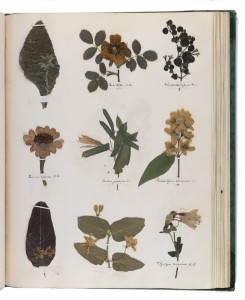 How did Emily Dickinson prepare her herbarium? That is the topic addressed in the current window display of the LuEsther T. Mertz Library’s Rare Book and Folio Room.
How did Emily Dickinson prepare her herbarium? That is the topic addressed in the current window display of the LuEsther T. Mertz Library’s Rare Book and Folio Room.
At 14 years of age, Dickinson, inspired by her readings and botanical studies at Amherst Academy, gathered, dried, pressed, mounted, and identified over 400 plants for her herbarium. She was enthusiastic about the project. She asked her friend Abiah Root in a letter if she had made a herbarium yet and encouraged her to pursue such a project. Dickinson even enclosed a geranium leaf for her friend to press.
In the Library’s William D. Rondina and Giovanni Foroni LoFaro Gallery exhibition of Dickinson’s life, which runs through August 1, a digitized version of the poet’s herbarium is on display. Made available through Turn the Pages Technology, visitors can view Dickinson’s original herbarium virtually by “turning” the pages on a touchscreen. A printed version of Dickinson’s herbarium is included in the Rare Book and Folio Room display.
This small exhibit shows how 19th-century botany enthusiasts created herbaria. The collecting tin (known as a vasculum) belonging to the celebrated botanist John Torrey is on display as well as a botany text by noted instructor Mrs. Almira Lincoln Phelps, a text that Dickinson used in her studies.
Also on view are the materials used in creating a herbarium today, including glue, twine, mounting paper, blotting paper, and a herbarium press. In addition, dried specimens of Monotropa uniflora (Indian pipe) and Heliotropium arborescens L. (heliotrope), two of Dickinson’s favorite plants, are presented, courtesy of the Garden’s William and Lynda Steere Herbarium..
The Rare Book and Folio Room display can be viewed during Library hours through Labor Day.
Posted in Emily Dickinson, Exhibitions on June 11 2010, by Plant Talk
Joyce Carol Oates Takes Center Stage at Poetry Series Saturday
This is the final weekend to experience first hand the life and works of one of America’s most treasured poets in Emily Dickinson’s Garden: The Poetry of Flowers.
- Celebrated poet Joyce Carol Oates and biographer Lyndall Gordon are among the esteemed poets and authors who will read their favorite Dickinson poems and discuss how she inspired their own work in the last installment of the poetry series My Emily Dickinson, co-sponsored by the Poetry Society of America.
- Visitors can participate in a marathon reading of themed Dickinson’s poems relating to death, bees, roses, flowers, birds, and trees.
- Dickinson scholar Judith Farr, author of The Gardens of Emily Dickinson, presents a lecture and slide show, Emily Dickinson in “Eden”: The Spring Garden.
- Tour Dickinson’s Victorian Homestead re-created in the Enid A. Haupt Conservatory and stroll along garden paths reading some of Dickinson’s most famous works near the flowers that inspired them in the Perennial Garden. This video gives you a peek at the exhibition.
- Enjoy guided tours, the Children’s Poetry Garden, and more.
And remember, the Gallery exhibition in the LuEsther T. Mertz Library, which gives an interactive perspective of Dickinson’s life through photographs, watercolors, manuscripts, her virtual herbarium, and her white dress fis on through August 1.
Get Your Tickets |
Posted in Emily Dickinson, Exhibitions on June 4 2010, by Plant Talk
Reclusive Poet’s Surviving Garment on Display in Library Gallery
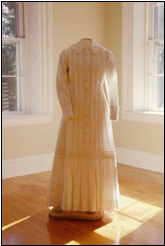 “A step like a pattering child’s in entry & in glided a little plain woman with two smooth bands of reddish hair . . . in a very plain & exquisitely white pique & a blue net worsted shawl.” This description Thomas Wentworth Higginson sent to his wife in 1870 has been pinned to Emily Dickinson for nearly 150 years. Mabel Loomis Todd heard about “the character” of Amherst almost as soon as she set foot in town in 1881: She “seems to be the climax of all the family oddity. . . . She dresses wholly in white, & her mind is said to be perfectly wonderful.” (Photo: Emily Dickinson dress, ca. 1878–82; white dress (reproduction), Emily Dickinson Museum Collection. Original, Amherst History Museum collection)
“A step like a pattering child’s in entry & in glided a little plain woman with two smooth bands of reddish hair . . . in a very plain & exquisitely white pique & a blue net worsted shawl.” This description Thomas Wentworth Higginson sent to his wife in 1870 has been pinned to Emily Dickinson for nearly 150 years. Mabel Loomis Todd heard about “the character” of Amherst almost as soon as she set foot in town in 1881: She “seems to be the climax of all the family oddity. . . . She dresses wholly in white, & her mind is said to be perfectly wonderful.” (Photo: Emily Dickinson dress, ca. 1878–82; white dress (reproduction), Emily Dickinson Museum Collection. Original, Amherst History Museum collection)
These contemporary accounts have fixed a compelling image through the decades of, well, oddity. Poetic genius is different from the norm. But odd, isn’t it, that the only full garment known to have belonged to Emily Dickinson and surviving to the present day is one white dress? This iconic garment belongs to the Amherst Historical Society, an exact replica is always on display at the Dickinson Homestead (now part of the Emily Dickinson Museum) in Amherst, and now one is on view in the LuEsther T. Mertz Library Gallery as part of the exhibition Emily Dickinson’s Garden: The Poetry of Flowers.
Read More
Posted in Emily Dickinson, Exhibitions on May 28 2010, by Plant Talk
 |
Noelle V. Dor is Museum Education Intern in the Everett Children’s Adventure Garden. |
The delicate unfurling of fresh leaves…
The kaleidoscopic flowering of plants small and large…
The courtship dances of birds and bees…
The cycling of sunshine and rain to nourish new life…
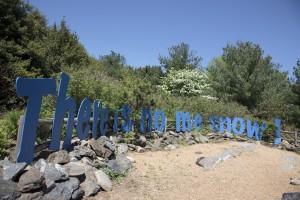 There is hardly a more poetic season than spring. All of nature is waking up and bursting forth in variously colored, scented, textured, and melodic ways. It’s no wonder that we, too, are moved to find refreshment for our own lives. When immersed in a space of natural beauty and vitality, some of us are even motivated to translate those experiences into artistic expressions. Inspired by well-versed poet and gardener Emily Dickinson, the Everett Children’s Adventure Garden has seamlessly blended nature and art to spark this dynamically creative process among visitors to the exhibition Emily Dickinson’s Garden: The Poetry of Flowers.
There is hardly a more poetic season than spring. All of nature is waking up and bursting forth in variously colored, scented, textured, and melodic ways. It’s no wonder that we, too, are moved to find refreshment for our own lives. When immersed in a space of natural beauty and vitality, some of us are even motivated to translate those experiences into artistic expressions. Inspired by well-versed poet and gardener Emily Dickinson, the Everett Children’s Adventure Garden has seamlessly blended nature and art to spark this dynamically creative process among visitors to the exhibition Emily Dickinson’s Garden: The Poetry of Flowers.
Read More
Posted in Emily Dickinson, Exhibitions, Programs and Events on May 21 2010, by Plant Talk
 |
Rob Casper is Programs Director of the Poetry Society of America. |
The New York Botanical Garden is in the midst of its exhibition Emily Dickinson’s Garden: The Poetry of Flowers, and the Poetry Society of America couldn’t be more excited!
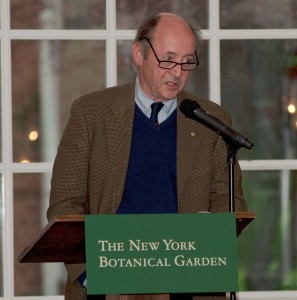 We’ve already had a great pre-launch during Poem in Your Pocket day (covered in this week’s “Talk of the Town” section in The New Yorker), with Mayor Bloomberg, Sigourney Weaver, and New York’s State Poet Jean Valentine. And our first My Emily Dickinson readings featured former U.S. Poet Laureate Billy Collins (pictured), award-winning poet Marie Ponsot, and Dickinson biographer Brenda Wineapple. There’s plenty to come, too, with readings and talks at the Garden by Bowery Poetry Club founder Bob Holman (May 22), scholar Christopher Benfey (June 4), poet and writer Joyce Carol Oates (June 12), former Queens Poet Laureate Stephen Stepanchev (June 12), and others, as well as corollary programs at the Belmont Public Library with a host of younger poets—including Mark Levine (May 27), Catherine Barnett (June 7), and Ada Limon (June 10)—reading from and speaking about the Belle of Amherst. Finally, the exhibition at the Garden will end with a weekend marathon reading of specific themes within Dickinson’s work, for which Garden visitors can sign up to participate in!
We’ve already had a great pre-launch during Poem in Your Pocket day (covered in this week’s “Talk of the Town” section in The New Yorker), with Mayor Bloomberg, Sigourney Weaver, and New York’s State Poet Jean Valentine. And our first My Emily Dickinson readings featured former U.S. Poet Laureate Billy Collins (pictured), award-winning poet Marie Ponsot, and Dickinson biographer Brenda Wineapple. There’s plenty to come, too, with readings and talks at the Garden by Bowery Poetry Club founder Bob Holman (May 22), scholar Christopher Benfey (June 4), poet and writer Joyce Carol Oates (June 12), former Queens Poet Laureate Stephen Stepanchev (June 12), and others, as well as corollary programs at the Belmont Public Library with a host of younger poets—including Mark Levine (May 27), Catherine Barnett (June 7), and Ada Limon (June 10)—reading from and speaking about the Belle of Amherst. Finally, the exhibition at the Garden will end with a weekend marathon reading of specific themes within Dickinson’s work, for which Garden visitors can sign up to participate in!
Read More
Posted in Emily Dickinson, Exhibitions on May 19 2010, by Plant Talk
 |
Jessica Blohm is Interpretive Specialist for Public Education. |
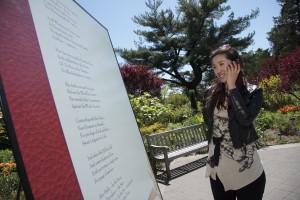 The exhibition Emily Dickinson’s Garden: The Poetry of Flowers features a Poetry Walk, a self-guided tour highlighting 35 of Dickinson’s poems on signs located among the Botanical Garden’s collections, near the plants and flowers that inspired her.
The exhibition Emily Dickinson’s Garden: The Poetry of Flowers features a Poetry Walk, a self-guided tour highlighting 35 of Dickinson’s poems on signs located among the Botanical Garden’s collections, near the plants and flowers that inspired her.
Visitors stroll along Perennial Garden Way—during the peak of spring flowering season—observing Dickinson’s muses such as daffodils, roses, daisies, tulips, and conifers.
An audio commentary, accessible by cell phone, illuminates her life and her love of nature, flowers, and gardens. Providing insight into her poetry are Dickinson experts Judith Farr, Professor Emerita of English and American Literature at Georgetown University and author of The Gardens of Emily Dickinson; Marta McDowell, historic garden specialist, instructor at The New York Botanical Garden, and author of Emily Dickinson’s Gardens: A Celebration of a Poet and Gardener; and Alice Quinn, Executive Director of the Poetry Society of America.
To access the audio tour, look for the audio tour symbol on signs on the Garden grounds. Call 718.362.9561, enter the prompt number noted on the sign followed by the # key.
For instance, enter 515# to hear an explanation of the Dickinson poem below. And enjoy!
I hide Myself within my flower,
That fading from your Vase,
You, unsuspecting, feel for me –
Almost a loneliness.
From The Poems of Emily Dickinson, ed. R.W. Franklin (Cambridge, Mass.: The Belknap Press of Harvard Univ. Press, 1998). F 80b
Posted in Emily Dickinson, Exhibitions on May 14 2010, by Plant Talk
Author Finds Striking Comparison with Garden’s Re-Creation
 |
Marta McDowell is author of Emily Dickinson’s Gardens: A Celebration of a Poet and Gardener and teaches landscape history at The New York Botanical Garden, where she studied landscape design.
|
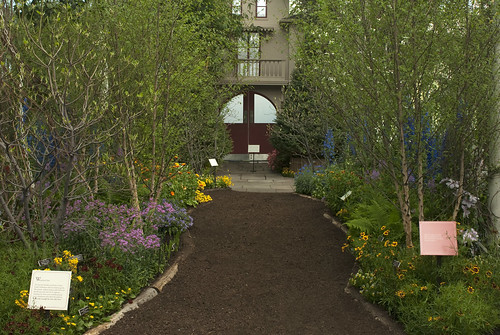 The other day I drove from the Botanical Garden to Amherst, Massachusetts, bookending a visit to Emily Dickinson’s Garden: The Poetry of Flowers with a call on Emily Dickinson’s home, the Homestead, at the Emily Dickinson Museum. Winding through Westchester County and western Connecticut, I turned onto Interstate 91 following the Connecticut River up the so-called Pioneer Valley, settled by Dickinson’s ancestors in search of good agricultural land. The unseasonably warm spring weather we were having trailed me north from the Bronx, with the temperature reading in the mid-80s on the car thermometer when I finally got to Emily’s B&B (where else?) on North Prospect Street.
The other day I drove from the Botanical Garden to Amherst, Massachusetts, bookending a visit to Emily Dickinson’s Garden: The Poetry of Flowers with a call on Emily Dickinson’s home, the Homestead, at the Emily Dickinson Museum. Winding through Westchester County and western Connecticut, I turned onto Interstate 91 following the Connecticut River up the so-called Pioneer Valley, settled by Dickinson’s ancestors in search of good agricultural land. The unseasonably warm spring weather we were having trailed me north from the Bronx, with the temperature reading in the mid-80s on the car thermometer when I finally got to Emily’s B&B (where else?) on North Prospect Street.
Read More
Posted in Emily Dickinson, Exhibitions, Gardening Tips on May 10 2010, by Sonia Uyterhoeven
 |
Sonia Uyterhoeven is Gardener for Public Education. Join her each weekend for home gardening demonstrations on a variety of topics in the Home Gardening Center. |
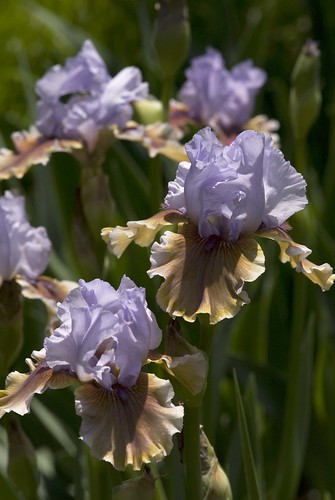 Last week in my blog we explored the history of the language of flowers. Today we’ll look at part of a floral index Emily Dickinson had access to. It is just a sampling of what a 19th-century index of flowers and their meanings would contain, but it is enough to get you started on learning the meanings of some common flowers.
Last week in my blog we explored the history of the language of flowers. Today we’ll look at part of a floral index Emily Dickinson had access to. It is just a sampling of what a 19th-century index of flowers and their meanings would contain, but it is enough to get you started on learning the meanings of some common flowers.
Many floral dictionaries were published in the United States in the late 18th and early 19th centuries. Some were simple indexes. Others were adorned with beautiful images of flowers and supplemented with literary extracts ranging from the works of Milton and Shakespeare to popular verse.
Emily Dickinson’s source for the language of flowers was more scholarly. She owned Almira H. Lincoln Phelps’ Familiar Lectures on Botany: Explaining the Structure, Classification, and Uses of Plants, with a Flora for Practical Botanists. This book contains a section titled “Symbolical Language of Flowers,” in which Phelps explains that “besides the scientific relations which are to be observed in plants, flowers may also be regarded as emblematical of the affections of the heart and qualities of the intellect.”
Read More
Posted in Emily Dickinson, Exhibitions, Programs and Events on May 7 2010, by Plant Talk
 |
Gayle Schmidt is Manager of Public Education. |
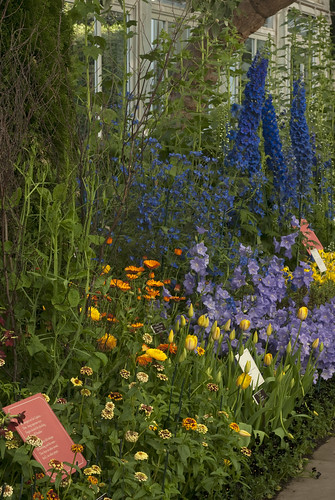 It’s not a surprise that the Garden is always busy on Mother’s Day—good children associate beautiful things like flowers with their nurturing mothers. The day gives us an opportunity to share out loud our appreciation for our moms for everything they do and have done each day of our lives.
It’s not a surprise that the Garden is always busy on Mother’s Day—good children associate beautiful things like flowers with their nurturing mothers. The day gives us an opportunity to share out loud our appreciation for our moms for everything they do and have done each day of our lives.
One of the activities the Garden has planned for the weekend during Emily Dickinson’s Garden: The Poetry of Flowers will help you explore more of the Garden and will allow you to create a card for Mom that says something special—in words and in flowers!
In Emily Dickinson’s day, a popular pastime was to make a tussie-mussie based on the period’s language of flowers— each flower representing a different meaning. Many books were sold as guides so that one could learn, for instance, what a secret admirer bearing flowers thought.
Read More
Posted in Emily Dickinson, Exhibitions on May 4 2010, by Plant Talk
 |
Jessica Blohm is Interpretive Specialist for Public Education. |
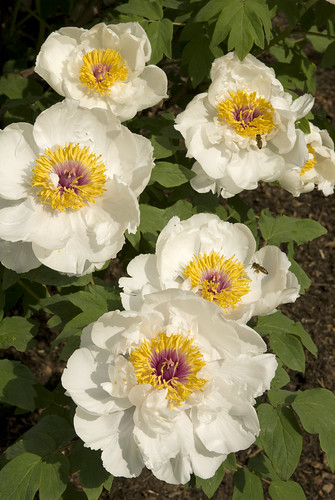 Scholars have long speculated about Emily Dickinson’s interest in plants. She was, in fact, an avid gardener and nature enthusiast. Many of her poems and letters allude to wildflowers and traditional herbaceous garden plants.
Scholars have long speculated about Emily Dickinson’s interest in plants. She was, in fact, an avid gardener and nature enthusiast. Many of her poems and letters allude to wildflowers and traditional herbaceous garden plants.
Emily Dickinson’s Garden: The Poetry of Flowers features in the Enid A. Haupt Conservatory a re-creation of Dickinson’s own mid-19th-century New England garden, an interpretation Garden curators have been able to craft from extensive research and careful reading of her poems and letters. On display are Dickinson’s favorites, including daisies, daylilies, tulips, roses, lilies, and others that inspired so much of her poetry. Not only did she grow plants, she also collected flowers from neighboring meadows and the surrounding landscape.
Flowers were one of her favorite metaphors; she used them as images in her poems and as subjects for her letters. Following is a selection of flowers that Dickinson was particularly fond of.
Today we spotlight the peony (Paeonia). Dickinson’s niece, Martha “Mattie” Dickinson Bianchi described “ribbons of peony hedges” growing along the edges of her aunt’s flower garden. Dickinson grew peonies in pink, white, and red. She often compared the pointed tips of the young shoots as they emerged from the ground in spring to red noses.
In a letter dated late April 1859 Dickinson says, “Tell Vinnie [her sister] I counted three peony noses, red as Sammie Matthews’s, just out of the ground.”
I hide Myself within my flower,
That fading from your Vase,
You, unsuspecting, feel for me –
Almost a loneliness.
Get Your Tickets

 How did Emily Dickinson prepare her herbarium? That is the topic addressed in the current window display of the LuEsther T. Mertz Library’s Rare Book and Folio Room.
How did Emily Dickinson prepare her herbarium? That is the topic addressed in the current window display of the LuEsther T. Mertz Library’s Rare Book and Folio Room.















